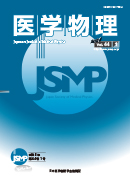
- Issue 3 Pages 37-
- Issue 2 Pages 21-
- Issue 1 Pages 1-
- |<
- <
- 1
- >
- >|
-
Sodai TANAKA, Taku NAKAJI, Hideyuki MIZUNO, Kota MIZUSHIMA, Ken KATAGI ...2024Volume 44Issue 1 Pages 1-7
Published: March 31, 2024
Released on J-STAGE: April 08, 2024
JOURNAL FREE ACCESSAt the National Institutes for Quantum Science and Technology (QST), a multi-ion therapy using helium, carbon, oxygen, and neon ions has been studied for charged particle therapy with more optimal biological effects. To make multi-ion therapy clinically feasible, a new treatment system was developed to realize the changes of the ion species in each irradiation using the Heavy Ion Medial Accelerator in Chiba (HIMAC). Since radiation therapy is safety-critical, it is necessary to construct a safety system that includes multiple safety barriers in the new treatment system for multi-ion therapy and to perform a safety analysis for the prevention of serious accidents. In this study, we conducted a safety analysis using event tree analysis (ETA) for newly introduced processes in the treatment planning, accelerator, and irradiation system of the multi-ion therapy. ETA is an optimal method to verify multiple safety barriers that are essential for medical safety and to shorten the time for safety analysis by focusing only on the new processes. Through ETA, we clarified the types of malfunctions and human errors that may lead to serious accidents in the new system for multi-ion therapy, and verified whether safety barriers such as interlock systems and human check procedures are sufficient to prevent such malfunctions and human errors. As a result, 6 initial events which may lead to serious accidents were listed in the treatment planning process, 16 initial events were listed in the accelerator system, and 13 initial events were listed in the irradiation system. Among these 35 initial events, 5 cautionary initial events were identified that could lead to serious final events and they had a probability of occurrence higher than 10−4. Meanwhile, the others were all initial events that do not lead to serious accidents, or the initial events that can lead to serious accidents but were considered to have sufficient safety barriers. The safety analysis using ETA successfully identified the system malfunctions and the human errors that can lead to serious accidents, and the multiple safety barriers against them were systematically analyzed. It became clear that the multiple safety barriers were not sufficient for some initial events. We plan to improve the safety barriers for the five cautionary initial events before the start of the clinical trial. Based on these findings, we achieved our objective to conduct a safety analysis for a new treatment system for multi-ion therapy. The safety analysis procedure using ETA proposed by this study will be effective when new systems for radiotherapy are established at QST and other facilities in the future as well.
View full abstractDownload PDF (766K)
-
Hidetoshi SAITOH2024Volume 44Issue 1 Pages 8-16
Published: March 31, 2024
Released on J-STAGE: April 08, 2024
JOURNAL FREE ACCESSDownload PDF (857K)
-
Weishan CHANG, Atsushi MYOJOYAMA, Kazumasa INOUE2024Volume 44Issue 1 Pages 17-19
Published: March 31, 2024
Released on J-STAGE: April 08, 2024
JOURNAL FREE ACCESSDownload PDF (558K)
-
[in Japanese]2024Volume 44Issue 1 Pages 20
Published: March 31, 2024
Released on J-STAGE: April 08, 2024
JOURNAL FREE ACCESSDownload PDF (212K)
- |<
- <
- 1
- >
- >|